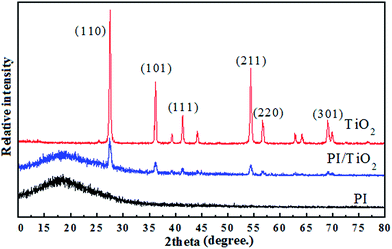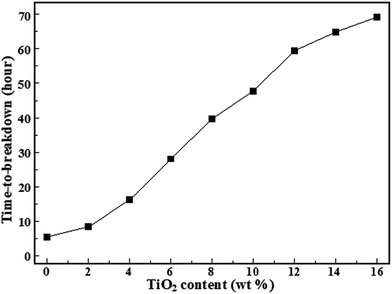 Open Access Article
Open Access ArticleCreative Commons Attribution 3.0 Unported Licence
Introduction of inorganic nano-particles into a polymer matrix to restrain the initiation and propagation of electrical trees in the corona condition
Chunyu Shang *,
Yanqiu Du and
Hui Kang
*,
Yanqiu Du and
Hui Kang
Department of Electronics and Information Engineering, Heilongjiang University of Science and Technology, Harbin 150022, China. E-mail: shang.chun.yu@163.com
First published on 21st November 2017
Abstract
In the corona condition, the initiation and propagation of electrical trees in a polymer matrix originates from the field enhancement effect. Driven by the alternating background electric field in the corona process, an alternating current would pass though the decomposition channel of the electrical tree, stimulating an enhanced local electric field on the tip of the electrical tree. When inorganic nano-particles with high corona-resistibility were introduced into the polymer matrix, in the corona process, the inorganic nano-particles were aggregatively deposited in the decomposition channels of the electrical trees and on the surface of the composite material. The decomposition channels were blocked and the alternating current was shut off, eliminating the enhanced local electric field on the tip of the electrical tree. As a result, the initiation and propagation of electrical trees were restrained and improved corona-resistibility was achieved for the polymer/nano-particles composite material.
1. Introduction
Owing to their excellent electrical, mechanical and thermal properties, polymer materials have been widely applied in the high-voltage insulation field.1–5 There are many kinds of polymer materials in insulation applications, such as polyimide, epoxy resin, polyethylene, and cross-linked polyethylene. However, in a long-term electrical erosion process, electrical trees are initiated and propagated in a polymer matrix in the corona condition. The initiation and propagation of electrical trees in a polymer matrix are typical pre-breakdown phenomena leading to insulation failure, significantly shrinking the life expectancies of polymer materials in insulation applications.6,7 Based on comprehensive investigation, we have revealed that in theory the initiation and propagation of electrical trees in a polymer matrix originate from the field enhancement effect. In the present research, in view of the field enhancement mechanisms, inorganic nano-particles with high corona-resistibility were deliberately introduced into the polymer matrix to restrain the initiation and propagation of electrical trees in the corona condition. By introducing inorganic nano-particles into the polymer matrix, improved corona-resistibility was verified to have been achieved in a corona experiment. Meanwhile, the mechanisms in improved corona-resistibility for polymer/nano-particles composite material are particularly discussed.2. Experimental section
Polyimide (PI) film and PI/TiO2 composite films (TiO2 content = 0 wt%, 2 wt%, 4 wt%, 6 wt%, 8 wt%, 10 wt%, 12 wt%, 14 wt%, and 16 wt%) were synthesized by in situ polymerization. In an ultrasonic bath, N,N-dimethylacetamide (DMAC, supplied by Tianjin Fuyu Fine Chemical Co., Ltd.) and TiO2 nano-particles with sizes of 30–100 nm (supplied by Beijing NaChen Technology Co., Ltd.) were added into a three-necked flask, and a stable suspension was formed after sufficient stirring and ultrasonic oscillation. A certain amount of 4,4′-oxy dianiline (ODA, supplied by Sinopharm Chemical Reagent Co., Ltd.) and pyromellitic dianhydride (PMDA, supplied by Sinopharm Chemical Reagent Co., Ltd.) were added into the suspension; after stirring, the mixture was cast on a glass substrate and dried at 80 °C for 6 h. After being successively cured at 120 °C, 200 °C and 300 °C for 2 h, PI film and PI/TiO2 composite films with thickness of about 30 μm were obtained. The XRD characterizations of PI, TiO2 and PI/TiO2 were undertaken with a Rigaku-D/max 2500 X-ray diffractometer using Cu Ka radiation. The time-to-breakdown measurements were performed under an alternating voltage of 1.7 kV in a rod-plate electrode system (IEC60343). An Al electrode was evaporated on each of the PI/TiO2 composite films (including the PI film). In the measurements, a tiny air gap was retained between the film and the rod electrode. The morphologies of the PI/TiO2 composite films were characterized using an environmental scanning electron microscope (ESEM) type Quanta 200 operated at 20 kV with secondary and backscattering electrons in high-vacuum mode.3. Results and discussion
3.1. Initiation and propagation of electrical trees in a polymer matrix owing to the field enhancement effect
In our research work, we have revealed that in theory the initiation and propagation of electrical trees in polymer matrix originate from the field enhancement effect.8 Herein, in order to carry out the discussions in this paper, the initiation and propagation mechanisms of electrical trees need to be referred to.When a conductor of a certain aspect ratio Rl0/ρ0 is parallel to the background electric field Ebackground between a pair of electrodes and the conductor is connected to one of the electrodes, free charges would be present on the top surface of the conductor. The radial and axial components of the electric field E(ρ,l) around the top of the conductor may be given as:
 | (1a) |
 | (1b) |
In the corona condition, a polymer matrix is under the action of a strong alternating background electric field Ebackground(t). The electrode-polymer interface is far from ideal at the microscopic scale. In a certain spot, there may be a sharp protrusion erected on the electrode surface (a conductive impurity particle or a defect of higher conductivity, etc.), embedded in the polymer matrix.1,2 In such a spot, stimulated by the alternating background electric field Ebackground(t) in the corona process, a field enhancement effect would be present around the projection top, as indicated in Fig. 1.
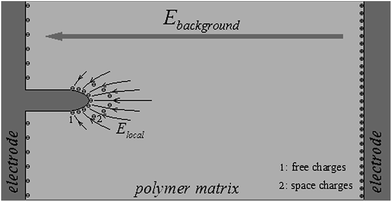 | ||
| Fig. 1 Schematic distributions of local electric field, free charges and space charges around the projection top when the background electric field is negative. | ||
When Ebackground(t) is negative (see Fig. 1), free charges (Qfree(t) < 0) would be distributed on the interface between the protrusion top and the polymer matrix (top–matrix interface), trapped in interface states with different energies (Eit) in the energy gap of the polymer matrix; the local electric field Elocal is oriented toward the protrusion top. Owing to the high strength of Elocal(t), the distributions of electrons in the interface states may not be stable; a trapped electron may be emitted into the polymer matrix via the quantum tunneling effect.12,13 Leaving the top–matrix interface, an electron should be accelerated by Elocal(t). After being constantly scattered, the electron should be finally trapped in a localized state, becoming a space charge in the polymer matrix around the protrusion top, as indicated in Fig. 1. When Ebackground(t) is positive, free charges (Qfree(t) > 0) would be distributed on the top–matrix interface; the local electric field Elocal is oriented outward from the protrusion top. Owing to the high strength of Elocal(t), the distributions of space charges (electrons) in the localized states in the polymer matrix around the protrusion top may not be stable; a trapped electron in the localized state may be emitted via the quantum tunneling effect. After being emitted, an electron should be accelerated by Elocal(t), be constantly scattered, and approach the protrusion top until it is recovered onto the top–matrix interface. In the corona condition, the magnitude of the alternating background electric field Ebackground(t) may be rather strong, bringing about a much stronger local electric field Elocal(t) around the protrusion top. Owing to the high strength of Elocal(t), the accumulated kinetic energies (Ek) of electrons in the accelerating processes may be high enough to break the chemical bonds, causing the decomposition of polymer material around the protrusion top, initiating an electrical tree on the surface of the polymer matrix.14
In the propagation of an electrical tree in a polymer matrix, different low-molecular decomposition products (especially carbonization products) would be deposited on the side wall of the decomposition channel, presenting a certain conductivity for the electrical tree. As a result, the electrical tree may be seen to be a quasi-conductor in the corona process.8,15–18 Driven by the alternating background electric field Ebackground(t), the alternating current Ichannel(t) would pass though the decomposition channel of the electrical tree, an alternating electric quantity Qspace(t) of space charges would be present on the tip of the electrical tree and an enhanced local electric field Elocal(t) would be present around the tip of the electrical tree. Based on experiment, it can be determined that the diameter of an electrical tree is of micrometer magnitude, and the tip of an electrical tree is even finer in size. Consequently, the magnitude of Qspace(t) on the tip of the electrical tree should be rather small. For a sinusoidal alternating electric field Ebackground(t), in the stable case, the alternating electric quantity Qspace(t) on the tip of the electrical tree and the alternating current Ichannel(t) passing though the decomposition channel of the electrical tree may be given as:
Qspace(t) = Qmax × sin![[thin space (1/6-em)]](https://www.rsc.org/images/entities/char_2009.gif) ωt ωt
| (2a) |
Ichannel(t) = ω × Qmax × cos![[thin space (1/6-em)]](https://www.rsc.org/images/entities/char_2009.gif) ωt ωt
| (2b) |
3.2. Introduction of inorganic nano-particles into a polymer matrix to restrain the initiation and propagation of electrical trees in the corona condition
In view of the initiation and propagation mechanisms of electrical trees in a polymer matrix, inorganic nano-particles with high corona-resistibility may be deliberately introduced into the polymer matrix and improved corona-resistibility may be expected for the polymer/nano-particles composite material.In our research, taking polyimide (PI, widely applied in engineering insulation) as a typical polymer material and titanium dioxide nano-particles (TiO2) as a typical inorganic component with high corona-resistibility, a series of experiments have been carried out. A PI/TiO2 composite material was formed by in situ polymerization. X-ray diffraction measurements were performed for PI, TiO2 and PI/TiO2 composite material, and the corresponding XRD data are presented in Fig. 2. The characteristic diffraction peaks were assigned to the TiO2 rutile phase and the broad band was assigned to the amorphous phase of the PI polymer matrix. With the introduction of TiO2 nano-particles into the PI polymer matrix, the characteristic diffraction peaks of TiO2 were superimposed on the broad band of PI in the XRD data of the PI/TiO2 composite material. To achieve comparability in the corona-resistibility measurements, the corona conditions were set to be uniform in all the experiments. With an increase in TiO2 content in the PI/TiO2 composite material, an improvement in corona-resistibility (indicated by time-to-breakdown) was apparent when the TiO2 content was not very high. The time-to-breakdown of PI/TiO2 composite film with TiO2 content of 0 wt%, 2 wt%, 4 wt%, 6 wt%, 8 wt%, 10 wt%, 12 wt%, 14 wt%, and 16 wt% was 5.5 h, 8.4 h, 16.5 h, 28.7 h, 39.9 h, 47.8 h, 59.4 h, 64.9 h and 68.8 h, respectively. The gradual increase in time-to-breakdown of the composite material indicated the improvement in corona-resistibility achieved by introducing inorganic nano-particles into the polymer matrix, as presented in Fig. 3.
3.3. Mechanisms in the improved corona-resistibility for the polymer/nano-particles composite material
In the propagation of an electrical tree in a polymer matrix, driven by the alternating background electric field Ebackground(t) in the corona condition, the alternating current Ichannel(t) would pass though the decomposition channel of the electrical tree to present the alternating electric quantity Qspace(t), stimulating the field enhancement effect on the tip of the electrical tree. If the decomposition channel of the electrical tree, as a quasi-conductor, were to be blocked by a certain means, Ichannel(t) may be shut off and Qspace(t) may be eliminated, dissipating the local electric field Elocal(t). As a result, the decomposition of the polymer material, i.e., the propagation of the electrical tree, may be restrained. Similarly, the initiation of an electrical tree on the surface of polymer matrix may be restrained as well.In the corona condition, the corona-resistibility is not uniform in a polymer/nano-particles composite material, so the propagation of electrical trees would inevitably bypass the inorganic nano-particles owing to the high corona-resistibility they possess. In this process, the polymer material around the inorganic nano-particles would gradually decompose, forming low-molecular decomposition products, and evaporating. Consequently, the inorganic nano-particles would be left in the decomposition channels of the electrical trees and on the surface of the composite material. Owing to the alternating current Ichannel(t) passing though the decomposition channels of the electrical trees (quasi-conductors in the corona process), a thermal effect would be present in the decomposition channels. Meanwhile, the surface energy of the inorganic nano-particles is much higher than that of the corresponding bulk material. With the propagation of electrical trees, the inorganic nano-particles left in the decomposition channels and on the surface of the composite material would be aggregatively deposited owing to the high surface energy and the thermal effect in the corona condition. The decomposition channels of the electrical trees would be blocked by the deposited inorganic nano-particles, shutting off the alternating current Ichannel(t) in the corona condition. Consequently, the field enhancement effect would be eliminated on the tip of the electrical tree and the propagation of electrical trees in the composite matrix may be restrained. With the decomposition of polymer material, the surface layer of the composite matrix would gradually collapse, with the deposition of inorganic nano-particles on the surface of the composite matrix. Consequently, the initiation of electrical trees on the surface of the composite matrix may be restrained as well.
In addition to the high surface energy of inorganic nano-particles, the melting point decreasing effect is another specific reason causing the deposited inorganic nano-particles to be aggregately deposited in the corona process. According to thermodynamics, the melting point of a certain crystal material is the specific temperature at which the solid and liquid phases possess the same vapor pressure.19 With an increase in temperature, the vapor pressures of solid and liquid phases would all increase, but the vapor pressure of the liquid phase would increase more slowly.19 Meanwhile, the vapor pressure of microscopic crystal particles would be higher than that of the macroscopic crystal.19,20 The relations between vapor pressure and temperature are schematically presented in Fig. 4. It is apparent that the melting point of microscopic crystal particles would be lower than that of the homogeneous macroscopic crystal. In the literature, the following relation is given,
 | (3) |
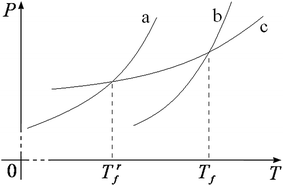 | ||
| Fig. 4 Schematic relations between vapor pressure and temperature. (a) Microscopic crystal; (b) macroscopic crystal; (c) liquid phase. | ||
Since the initiation and propagation of electrical trees in the corona condition may be restrained by introducing inorganic nano-particles into the polymer matrix, improved corona-resistibility for a polymer/nano-particles composite material would inevitably be achieved. The SEM morphologies of the PI film and PI/TiO2 composite film before and after the corona experiments are presented in Fig. 5.
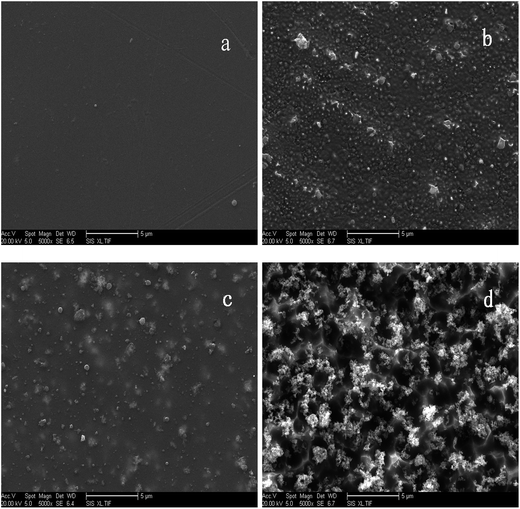 | ||
| Fig. 5 SEM morphologies of pre-corona PI film (a), post-corona PI film (b), pre-corona PI/TiO2 composite film (c) and post-corona PI/TiO2 composite film (d). | ||
As verified by experiment and reported in the literature, inorganic nano-particles are more suitable than homogeneous inorganic micron-particles for introduction into the polymer matrix to restrain the initiation and propagation of electrical trees in the corona condition. Based on the initiation and propagation mechanisms of electrical trees presented in our research, the corresponding reasons may be exactly clarified. In the polymer/micron-particles composite material, with the decomposition of polymer material propagating into the composite matrix in the corona process, inorganic micron-particles would be deposited in the decomposition channel and on the surface of the composite matrix. It should be noted that the interspaces between the deposited micron-particles should be of sub-micrometer magnitude, which are much larger than those in the deposited nano-particles. On the other hand, in typical polymer materials, the diameter size of an electrical tree ranges from a few tenths of a micrometer to tens of micrometers. Owing to the relatively large interspaces between the deposited micron-particles, the decomposition channels of electrical trees may not be sufficiently blocked and the alternating current Ichannel(t) in the decomposition channel may not be sufficiently shut off in the corona process. As a result, the propagation of electrical trees may not be effectively restrained. Similarly, the initiation of electrical trees may not be effectively restrained as well in the corona process. Consequently, the improvement in corona-resistibility may not be sufficiently achieved by introducing inorganic micron-particles into the polymer matrix.
4. Conclusions
As a long-term electrical erosion process, electrical trees are initiated and propagated in a polymer matrix in the corona condition. The initiation and propagation of electrical trees originate from the field enhancement effect. In view of the initiation and propagation mechanisms of electrical trees, inorganic nano-particles with high corona-resistibility may be introduced into the polymer matrix and a high corona-resistibility may be expected for a polymer/nano-particles composite material. In experiments, an apparent improvement in corona-resistibility was achieved for a PI/TiO2 composite material. The time-to-breakdown of PI/TiO2 composite film with a TiO2 content of 0 wt%, 2 wt%, 4 wt%, 6 wt%, 8 wt%, 10 wt%, 12 wt%, 14 wt%, and 16 wt% was 5.5 h, 8.4 h, 16.5 h, 28.7 h, 39.9 h, 47.8 h, 59.4 h, 64.9 h and 68.8 h, respectively. In addition, in view of the initiation and propagation mechanisms of electrical trees, inorganic nano-particles are more suitable than homogeneous inorganic micron-particles for introduction into the polymer matrix owing to the relatively large gaps between the deposited micron-particles, as verified by experiment.Conflicts of interest
There are no conflicts to declare.Acknowledgements
This work was financially supported by Heilongjiang postdoctoral scientific research developmental fund (LBH-Q15124), Science and Technological Research Project of Heilongjiang Provincial Education Department (1253052).References
- R. Gautam, R. Vinu, R. Sarathi, S. Acharya, M. Kumar and A. Sharma, IEEE Trans. Dielectr. Electr. Insul., 2016, 23, 1652 CrossRef CAS.
- Y. Tanaka, G. Chen, Y. Zhao, A. E. Davies, A. S. Vaughan and T. Takada, IEEE Trans. Dielectr. Electr. Insul., 2003, 10, 148 CrossRef CAS.
- H. Kim, S. Nam and J. Park, Semicond. Sci. Technol., 2010, 25, 105006 CrossRef.
- R. Sarathi, A. Nandini and M. G. Danikas, JEE, J. Electron. Eng., 2011, 62, 73 Search PubMed.
- X. Shang, D. Han, M. Liu and G. Zhang, RSC Adv., 2017, 7, 5055 RSC.
- L. R. Zhou, G. N. Wu and B. Gao, IEEE Trans. Dielectr. Electr. Insul., 2009, 16, 1143 CrossRef CAS.
- J. W. Zha, Z. M. Dang and H. T. Song, J. Appl. Phys., 2010, 108, 09113 CrossRef.
- C. Y. Shang, J. X. Zhao, X. Q. Wang, H. Y. Xia and H. Kang, RSC Adv., 2015, 5, 16993 RSC.
- L. Q. Guo, D. Han, H. Ma, K. Y. Song, H. N. Wu and S. Wang, J. Synth. Cryst., 2007, 36, 847 Search PubMed.
- C. Y. Shang, J. X. Zhao and X. Q. Wang, Phys. Chem. Chem. Phys., 2016, 18, 3482 RSC.
- S. H. Guo, Electrodynamics, Higher Education Press, 1997 Search PubMed.
- J. Y. Zeng, Quantum mechanics, Science Press, Beijing, 2008 Search PubMed.
- E. K. Liu, B. S. Zhu and J. S. Luo, Semiconductor Physics, National Defense Industry Press, 2015 Search PubMed.
- X. Shang, Y. Li, Q. Zhan and G. Zhang, New J. Chem., 2016, 40, 1111 RSC.
- S. Misak, J. Fulnecek, T. Jezowicz, T. Vantuch and T. Burianek, Power Engineering and Electrical Engineering, 2017, vol. 1, p. 21 Search PubMed.
- X. R. Chen, Y. Xu, M. Wang, W. H. Yang, Y. Liu and X. L. Cao, High Voltage Engineer, 2012, vol. 38, p. 645 Search PubMed.
- X. R. Chen, Y. Xu, Y. Liu and X. L. Cao, Acta Phys. Sin., 2012, 61, 087701 Search PubMed.
- G. N. Wu, J. D. Wu, K. Zhou, B. Gao, X. X. Guo and W. G. Wang, Chinese Society for Electrical Engineering, 2009, 29, 13 Search PubMed.
- B. H. Jiang, Material Thermodynamics, Shanghai Jiaotong University Press, Shanghai, 1999 Search PubMed.
- B. X. Du, Y. Q. Xing, J. X. Jin, P. H. Huang and M. Xiao, IEEE Trans. Appl. Supercond., 2016, 26, 1051 Search PubMed.
- M. J. Maclachlan, L. Manners and G. A. Ozin, Adv. Mater., 2000, 12, 675 CrossRef CAS.
| This journal is © The Royal Society of Chemistry 2017 |

